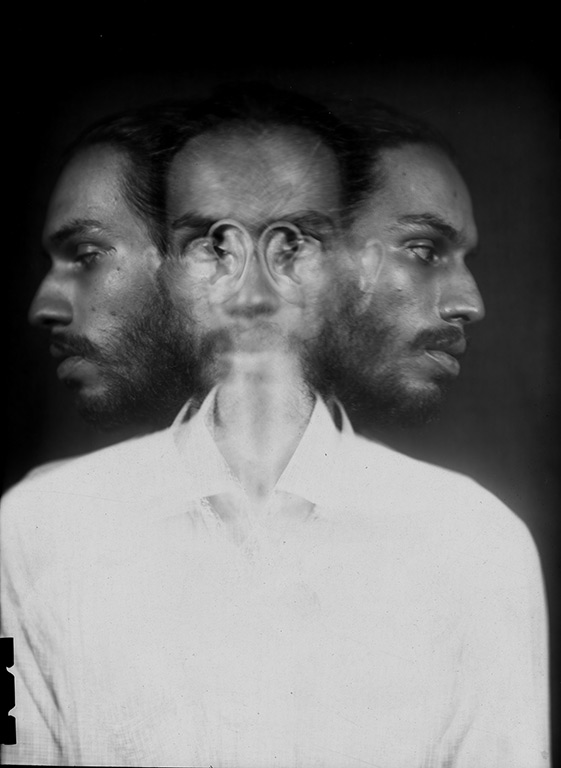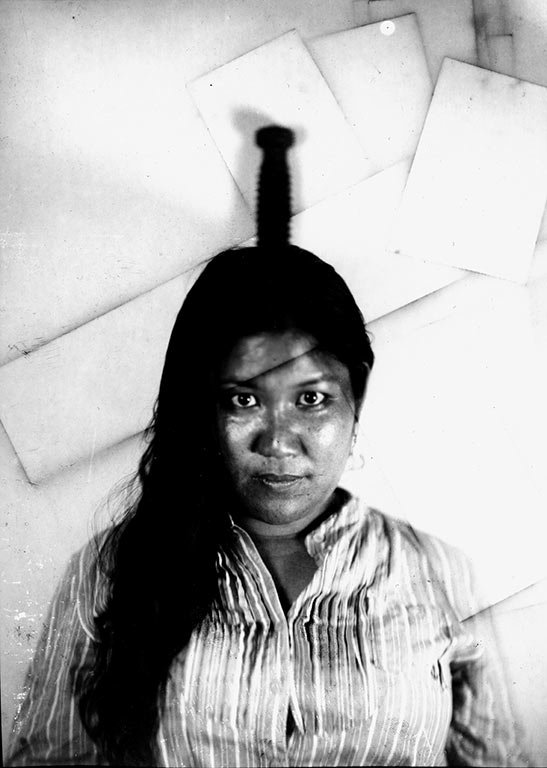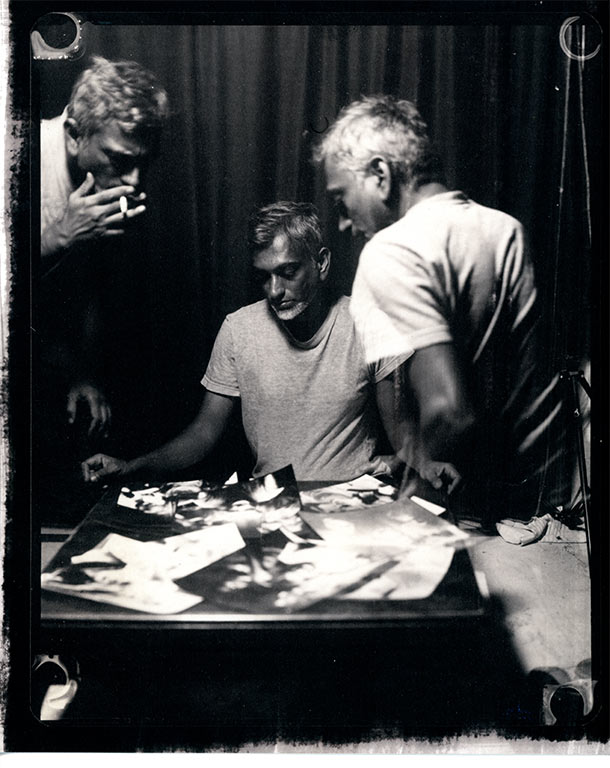A Shot in the Dark
An interview with Edson Beny Dias, one of the few alternative photographers in the country, who revels in the process of creation as much as in the creation itself – so much so that it is hard to delineate the two
Praveena Shivram
The quiet glow of the safelight and the shadows it casts on the walls in the darkroom was immediately comforting, and therefore surreal. I could smell the wet film which was strangely addictive; the swish of water and chemicals as I moved from tray to tray with nervous, inexperienced hands wasn’t as meditative as I imagined it to be, but the way the image emerged like a lost reflection was exactly as I thought magic in Narnia would be (because we all know magic was very different at the Shire) – sudden, mysterious and immensely powerful. It arrests you, this nothing becoming something, this blankness filling up with lines and people and structure and light. It creates a memory, a very tangible memory, of hands that have clicked the image to hands that process it, and you wonder when did this memory slip and slide into oblivion? When did it become a nonentity, shoved into the overcrowded attic of the past, where the only glimmer of sunlight is saved for the dust fairies? ‘There is nothing wrong with being charmed by the glamour of the past,’ says Edson Beny Dias, one of the few alternative photographers in the country. ‘Certain sights, visuals or smell always trigger a memory. I still remember the first time I saw an image appear before my eyes in a friend’s darkroom. It was that moment I knew that this is what I want to do for as long as it intrigues me. For me it is not nostalgia because I never moved away from this medium. It has always been a medium of my choice,’ he adds. He not only shoots and processes his photographs the old way but also spends years and months constructing the perfect camera for his purpose – size, labour, tediousness be damned. The camera becomes the centre of his photographic landscape without coveting the spotlight, maintaining a respectful distance, instead, from the subject and the artist, giving us, the viewer, the distance of performance and the intimacy of memory.

As part of his exhibition, Voices, Edson brought a raw, contemporary edge to the black and white medium taking the traditional process of photographing beyond its assumed structure. As Anjali D’Souza, a Jung psychologist and who has been collaborating with Edson on several projects for the past 15 years, says, ‘Edson, for this series (Voices) turns his gaze inwards capturing the richness of his own psyche. The voices that push, pull, criticise, grieve, sort and sift, search and imagine: a multi-layered, thick, slow process that often is absent and invisible on the outside. He almost concretises his inner world through the performativity of the image, and yet invites us to partake in its highly symbolic and complex quality, with our own imagination participating in the drama of his life.’
Excerpts from the interview
What does the ‘camera’ – the physical, tangible camera – actually mean to you?
A camera in itself is just a tool. Camera Obscura, for example, was a particular project that I had in my mind, and so I felt it would be the perfect tool for that project. It was primarily for making portraits of friends in Delhi who are artists, and it also doubled as my personal darkroom. I like to have physical involvement of the entire process of making an image, or rather be involved as much as I can. It may seem like a laborious process but if you enjoy what you do, it’s not that complicating. This kind of involvement makes it tangible. In case I don’t have a particular camera as a tool for a particular project, then I will create it.

When the process of constructing a camera, like in the case of your Camera Obscura project, becomes so vital, followed by the significance of how you then process the images in the darkroom, do you sometimes find the aesthetics of taking a photograph is relegated to the background with the constant temptation to experiment?
Like I mentioned, the Camera Obscura was created for taking portraits and it served the purpose. The frame, the subject and the lighting are arranged accordingly to capture the subject in a mood that I require. So there is basically no clash between the two; rather they are complementary to each other. Since the camera is so big that you can’t move it around, I just have to worry about the subject and the light source.
Do you think the fact that you are using alternate modes of taking and processing your portraits, it is somehow liberating that we the audience know this and therefore experience your photographs differently? Or do you think it is the image that gives the experience, irrespective of how one perceives them?
Personally, I’d rather the viewer engages with the visuals emotionally in some way or other, rather than be fascinated by the process by which the photograph was made. The process or medium that I chose to make the photograph is my personal choice. Just as an artist may use oil paint or acrylic or water colours on canvas.

I found the Morung Camera Obscura project in Nagaland fascinating for the cultural references a Morung has and how the camera transformed that understanding. For you, what was more exciting – this marriage of culture and process or the challenge of lending new meaning to an old custom and its eventual acceptance by the audience?
To be honest, I never thought of it this way. I was just revisiting friends in Mokokchung, Nagaland. One evening, after drinking a few bottles of rice beer and looking at some of the beautiful Morung houses, I thought to myself, why not have some fun? And that’s how the whole project began. It wouldn’t have been possible if it wasn’t for the wonderful support from the Ao Naga folks from Mokokchung. The local craftsmen lent their skills, the forest provided all the raw materials, everyone had fun, and the smoked pork and rice beer were amazing. The whole experience was as surreal as an Anthony Bourdain episode, except that we also made a camera in the shape of a Morung house and took a few pictures with it.
You mentioned taking the Camera Obscura project to Mumbai as well, and to have workshops on bringing the physical experience of photographing to participants. As an artist, would it be less or more gratifying for your workshops to become more than one-time experiences?
It is not just about Mumbai; I would like to take it to other cities as well. Presentations and workshops are part of the way to promote alternative photography. I hope more people get intrigued and inspired to incorporate this medium into their artistic practice. Hopefully, some day, we will have a community darkroom in every city.

What changes in how you view an image when the physicality of the camera and the process is so intrinsic to your practice?
I visualise the final image before I shoot, so every image is constructed. I know how long it is going to take, and I am willing to invest that time. The editing is already done visually before the shoot. The camera and the process come in after I decide what it is that I need to say in my photographs. My project Voices took eight years of planning, and a few days to shoot. I didn’t click more than six to seven exposures to get four good printable negatives. What took more time was to create the sets for the shoot and about 10 days of darkroom labour to make the prints. One of the most fascinating things about this process is that even your mistakes and test strips are very beautiful and I have saved many of these test strips over the past 15 years or so. This may sound funny, but I value my test strips as much as my final prints. My retirement plan is to make a collage out of it. There are memories associated with all these prints – how it came about, what happened at the time… it is like a chronicle of all those moments.
This is question I like to ask most artists – how much of yourself do you put into your work? In your case, though, I am curious to know that given the process itself is so long, how do you sustain the ‘you’ in the you-ness of the artist?
It is all about me. My visualisation, me as a camera designer, me as a craftsman making the camera, me as the alchemist making the final prints, and me as the subject since I am my biggest muse.
And, finally, what do you think the practice of alternative photography brings to the larger continuum of photography – preserving the old or creating the new?
To me it doesn’t matter; I would do it as long as I enjoy it. But, it is important that the practice has a life of its own. It should reach out to more people. I would do as much and as long as I can to pass the knowledge on.

All images Courtesy Edson Beny Dias
Share